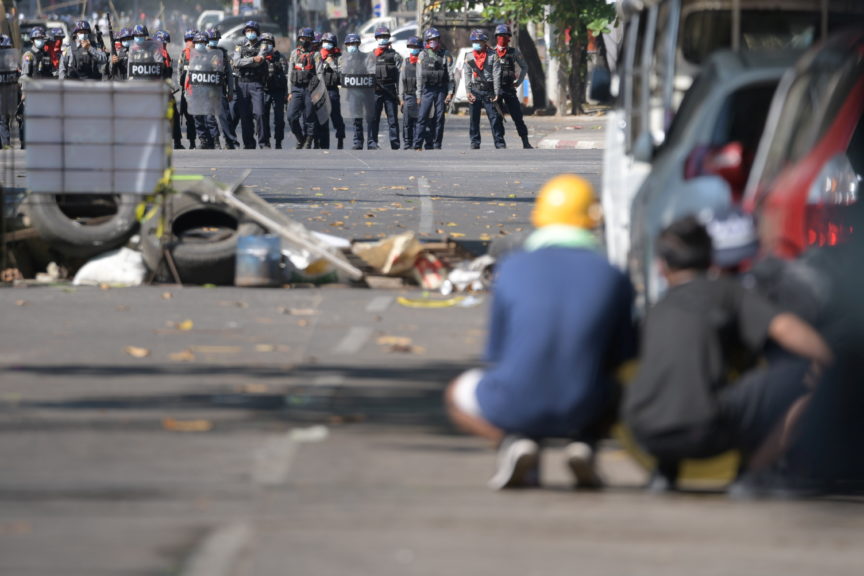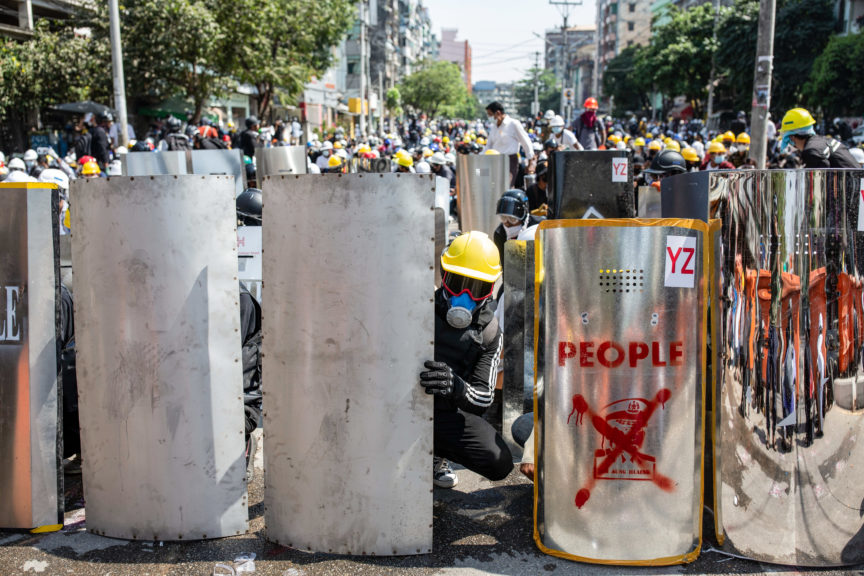Outgunned and Unsupported, Myanmar’s Resistance Isn’t Giving Up
Revolutionaries say ‘the military can be beaten’.
by Zar Ni & Ben Dunant
1 February 2022

When Thida Htwe joined mass protests in February last year, she was convinced that “if we showed our will, the military dictator would have to give up power.”
The 53-year-old schoolteacher was emboldened by seeing so many of her colleagues take to the streets in Mandalay, Myanmar’s second city, following the military’s seizure of power on 1 February from the elected administration of Aung San Suu Kyi.
“The parents of our students cheered us on,” she said. “I joined the protests every day until I was chased down by soldiers.”
If she had been caught, she could have faced torture, sexual violence and death in military detention, cases of which have been amply documented as the junta has striven to crush the mass uprising against its rule.
Thida Htwe, whose real name is being withheld to protect her identity, remains on the run. A warrant was issued for her arrest, on a charge of criminal incitement, in April last year. Shortly afterwards, soldiers broke into, searched and padlocked the empty home she once shared with her husband and three children.

Speaking to Novara Media from hiding, Thida Htwe said she had placed her faith in a peaceful, nationwide campaign of civil disobedience. At the campaign’s core was a strike by civil servants like Thida Htwe, who had taught at government schools for almost 30 years. The aim, she said, was to “stop the [junta’s] administrative machinery” in its tracks and make it impossible for the military to govern.
Thida Htwe wanted to set a good example for her students. “I don’t want them to think that anyone can do whatever they want, so long as they’re armed,” she said. Yet despite her initial commitment to non-violence, the military’s brutality soon convinced her that the people had a right to defend themselves.
Thida Htwe said she supports the colleagues that have switched from civil disobedience to an armed fightback against the junta. “They don’t like armed struggle, but the dictator [senior general Min Aung Hlaing] pushed them to join armed groups by killing innocent people,” she said, referring to the massacres of protesters that began in March last year.
Far from crushing the resistance, this violence has simply made it change course. Since April, there have been regular guerrilla bombings and assassinations in major cities like Yangon and Mandalay and full-scale revolts in rural areas, particularly Sagaing region and Chin state in the west and Kayah state in the east.
Myanmar’s youth have been on the frontlines of this fight. They include teenagers like Nan Htwe, who left her home in the countryside south of Yangon, Myanmar’s largest city, in September to join a newly-formed armed group near the country’s eastern border with Thailand in Kayin state.
The 19-year-old, who spoke to Novara Media by telephone from her base, said she left without telling her parents, whom she had helped most days on the family farm since her three older brothers moved away. Her mother later phoned her, begging her to come home. “You’re the only one for us,” her mother said, crying, but Nan Htwe told her she had “no plan to return home before the revolution succeeds”.

The armed resistance’s largely grassroots nature has been both a strength and a weakness. What it has in popular support and energy, it lacks in overall coordination.
The National Unity Government (NUG), a parallel administration formed by deposed MPs and ethnic minority leaders to lead the anti-coup struggle, has attempted to provide cohesion and top-down support through the creation of a defence ministry and the declaration in September of a “defensive war” against the junta. However, the dozens of anti-coup armed groups that have formed over the last year largely operate on their own initiative, or in small local alliances. Many also fight with homemade guns and explosives, or whatever weapons they’re able to loot in raids on army or police posts.
“We haven’t received any weapons from the NUG,” said Nan Htwe. Despite completing a gruelling training, her company of 50 soldiers has only three guns to share between them, leaving them largely unable to take the fight to the junta. “All members want to go to the front line,” she said, but the lack of weapons means they can only “run and hide”.
Because of the military’s superior firepower, resistance has come at a steep human cost, with more than 300,000 people displaced by fighting, according to the UN. Consistent with its approach over decades of war with ethnic minorities in the country’s mountainous borderlands, the military has inflicted collective punishment on communities, reportedly burning and looting their villages or targeting them in airstrikes.
These atrocities, which include the reported massacre and burning of 35 people, including children, in Kayah state on Christmas Eve, have sparked international outrage but little action. Targeted sanctions by western nations have only limited impact on a military that is accustomed to being a pariah, and China and Russia are bound to protect the regime from more coordinated action through their veto at the UN Security Council. And while placards at the early protests called for the US military to “save” Myanmar, western powers are unlikely to intervene militarily.

With little prospect of meaningful foreign help, Nan Htwe believes “we won’t succeed any time soon”. However, she remains optimistic in the long run, because while the junta’s soldiers are “brutal and evil”, they are just blindly following orders and don’t have a strong will to fight. By contrast, “we can think for ourselves and use our intelligence,” she said.
Thida Htwe agrees, believing the junta can’t endure in the face of such overwhelming public hostility. The striking teacher said: “The military’s strength is they have arms and no shame, and can do cruel things to people without thinking much. Their weakness is that they have made the whole population resent them.”
She maintained that, besides armed struggle, peaceful methods of civil disobedience also remain important. She quoted figures, which Novara Media confirmed with the NUG’s education ministry, that out of an estimated 400,000 government schoolteachers, about 250,000 remain on strike. Despite the loss of salaries and staff housing, difficulties finding new work and the prospect of public donations drying up amid a bleak economic outlook, they remain resolute, she said.
“If we continue to do what we’ve done, the military can be beaten.”
Correction: This article was amended on 3 February to say that according to NUG figures around 250,000 teachers remain on strike, rather than 150,000.
Zar Ni lives in exile after working in Yangon, Myanmar, for ten years.
Ben Dunant is a journalist covering Myanmar and is an editor-at-large at Frontier Myanmar magazine.


